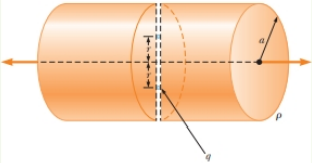
Concept explainers
You are working for the summer at a research laboratory. Your research director has devised a scheme for holding small charged particles at fixed positions. The scheme is shown in Figure P23.36. An insulating cylinder of radius a and length L >> a is positively charged and carries a uniform volume charge density ρ. A very thin tunnel is drilled through a diameter of the cylinder and two small spheres with charge q are placed in the tunnel. These spheres are represented by the blue dots in the figure. They find equilibrium positions at a distance of r on opposite sides of the axis of the cylinder. Your research director has had great success with this scheme. (a) Determine the specific value of rat which equilibrium exists. (b) Your research director asks you see if he can extend the system as follows. Determine if it is possible to add transparent plastic tubes as extensions of the tunnel and have the small spheres be in equilibrium at a position for which r > a.
Figure P23.36

Trending nowThis is a popular solution!

Chapter 23 Solutions
Physics for Scientists and Engineers
- A block of mass 1.4 kg is attached to a horizontal spring that has a force constant 900 N/m as shown in the figure below. The spring is compressed 2.0 cm and is then released from rest. a x = 0 x b (a) A constant friction force of 4.4 N retards the block's motion from the moment it is released. Using an energy approach, find the position x of the block at which its speed is a maximum. cm (b) Explore the effect of an increased friction force of 13.0 N. At what position of the block does its maximum speed occur in this situation? cmarrow_forwardA block of mass m = 3.00 kg situated on a rough incline at an angle of 0 = 37.0° is connected to a spring of negligible mass having a spring constant of 100 N/m (see the figure below). The pulley is frictionelss. The block is released from rest when the spring is unstretched. The block moves 11.0 cm down the incline before coming to rest. Find the coefficient of kinetic friction between block and incline. k=100 N/m Ө marrow_forward23. What is the velocity of a beam of electrons that goes undeflected when passing through perpendicular electric and magnetic fields of magnitude 8.8 X 103 V/m and 7.5 X 10-3 T. respectively? What is the radius of the electron orbit if the electric field is turned off?arrow_forward
- 10. A light bulb emits 25.00 W of power as visible light. What are the average electric and magnetic fields from the light at a distance of 2.0 m?arrow_forward9. Some 1800 years ago Roman soldiers effectively used slings as deadly weapons. The length of these slings averaged about 81 cm and the lead shot that they used weighed about 30 grams. If in the wind up to a release, the shot rotated around the Roman slinger with a period of .15 seconds. Find the maximum acceleration of the shot before being released in m/s^2 and report it to two significant figures.arrow_forwardIn the movie Fast X, a 10100 kg round bomb is set rolling in Rome. The bomb gets up to 17.6 m/s. To try to stop the bomb, the protagonist Dom swings the counterweight of a crane, which has a mass of 354000 kg into the bomb at 3.61 m/s in the opposite direction. Directly after the collision the crane counterweight continues in the same direction it was going at 2.13 m/s. What is the velocity (magnitude and direction) of the bomb right after the collision?arrow_forward
 Physics for Scientists and Engineers: Foundations...PhysicsISBN:9781133939146Author:Katz, Debora M.Publisher:Cengage Learning
Physics for Scientists and Engineers: Foundations...PhysicsISBN:9781133939146Author:Katz, Debora M.Publisher:Cengage Learning College PhysicsPhysicsISBN:9781938168000Author:Paul Peter Urone, Roger HinrichsPublisher:OpenStax College
College PhysicsPhysicsISBN:9781938168000Author:Paul Peter Urone, Roger HinrichsPublisher:OpenStax College Principles of Physics: A Calculus-Based TextPhysicsISBN:9781133104261Author:Raymond A. Serway, John W. JewettPublisher:Cengage Learning
Principles of Physics: A Calculus-Based TextPhysicsISBN:9781133104261Author:Raymond A. Serway, John W. JewettPublisher:Cengage Learning Physics for Scientists and Engineers with Modern ...PhysicsISBN:9781337553292Author:Raymond A. Serway, John W. JewettPublisher:Cengage Learning
Physics for Scientists and Engineers with Modern ...PhysicsISBN:9781337553292Author:Raymond A. Serway, John W. JewettPublisher:Cengage Learning College PhysicsPhysicsISBN:9781305952300Author:Raymond A. Serway, Chris VuillePublisher:Cengage Learning
College PhysicsPhysicsISBN:9781305952300Author:Raymond A. Serway, Chris VuillePublisher:Cengage Learning Physics for Scientists and EngineersPhysicsISBN:9781337553278Author:Raymond A. Serway, John W. JewettPublisher:Cengage Learning
Physics for Scientists and EngineersPhysicsISBN:9781337553278Author:Raymond A. Serway, John W. JewettPublisher:Cengage Learning





